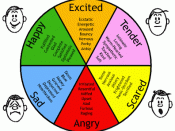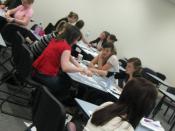The aim of this assignment was to analyze the one of conflicts occurring at my workplace and to provide a solution plan for it. Understanding the nature and identifying the type of the conflict is essential to managing it. There is issue based or substantive and emotional based or personalized conflicts. We can make a difference between constructive and destructive ones. Issue based constructive conflicts can drive the organization for development, but emotion based destructive conflicts can destroy the operation. Different kind of conflicts requires different handling types. I introduced the five handling type model. These are based on how assertive we are in expressing our own interests and how much we take other's interests into account.
There are several theories in the literature, which emphasizes one of these aspects. Communication aspect defining conflict as: "the tension between two or more entities - individuals, groups or organizations - which arise from the incompatibility of actual or desired responses" (Gamble & Gamble 2002).
Perceptional aspect focuses on personal conflicts: "Interpersonal conflict occurs between two or more persons when attitudes, motives, values, expectations or activities are incompatible and if those people perceive themselves to be in disagreement" (Gamble & Gamble 2002). But there are different types of conflict that fit these definitions. We need to understand what kind of conflict we're dealing with before we can select the appropriate conflict-resolution tool to resolve it. Let's look at the one of conflicts in my organization as follow.
In this case the place of the situation is a bank's dealing room. I was appointed for the position when previous chief leader left the company. In several cases I have to realize that dealers do not fulfill my direct requests. I will show the one instance out of many in follow:
Last Monday, I held the meeting and assigned the whole dealers to submit the work summary in April to me before Friday. However, they told an angry tone with me that they have no time to write down and can not complete the mission at all. And then all dealers left the meeting room and let me stay alone. I was so angry with them destructs my reputation and commanded them to submit the work summary before my deadline. Furthermore, I told them seriously I won't accept any excuses to fail my order. I really cannot bear that they were always late with my deadlines, and the quality of their work was not appropriate. Basically I am satisfied with their professional performance, but I have problems with their attitude. So the mess in the dealing room is unbelievable.
This is a destructive, emotional based personal conflict, between my old colleagues and me. Personalized conflict is fuelled primarily by emotion and perceptions about someone else's personality, character or motives. When conflict is personalized and extreme each party acts as if the other is suspect as a person. In this case problem solving never works, because it is about emotion and not issues. These kinds of conflicts almost always get worse over time, if they cannot be converted to substantive conflict.
There are three areas of conflict will include. Firstly, it is inevitable part of the communication with fellow workers. As a chief dealer, I am in charge of the operational tasks and liquidity, interest rate, and exchange rate management. I am the manager of the dealing room, so it is inevitable what fulfilled the order that I gave them. However, the dealers have low regard for my work. Secondly, it is inconsistency in communication or behavior. I failed to communicate properly my goals and incentives to the group members; I was easily to get angry why the dealers still failed to my direct requests. Nevertheless, they used to regard nonsensical excuses as the reason of late. As a result, we argued with each other everyday. Thirdly, it is different intentions, value systems, attitudes and beliefs. I was serious about the work attitudes and wanted to gain the wonderful performance. However, they still do not feel the change in my position, and they do not want to handle me as a boss. They are a bit suspicious about my lead, there should be some kind of disappointment and unexpressed feelings behind their behavior.
After the analysis of the current situation according to the previous chapter, the next step to find out the most appropriate style to deal with the problem. As a result of a conflict sometimes people fail to work together or even to communicate. When things descend into conflict situation, it is a hard and intensive work to restore the peace in the workplace. We have to consider the different conflict styles we might use in different situations and with different types of people. There are five styles based on how assertive we are in expressing our own interests and how much we take other's interests into account.
Five styles (Canary, Cody & Manusov, 2000) has shown a serious of outcomes when people choose different kind of styles. Firstly, it can cause the conflict to escalate and the second party may try to retaliate when we choose confrontational style. Secondly is called accommodating style, going along with what the other wants. Accommodation is appropriate only when a party recognizes that he is wrong. Otherwise it is dangerous because the second party may lose credibility and influence. Thirdly, it can be a win-win situation, collaborating style, discussing each other's concerns and interests. Fourthly, it may be the best solution if it is clear that doing something is destructive and it is named avoiding style, avoiding or delaying the dealing with the conflict. Lastly, it is compromising style, both parties giving up a something to resolve the problem. The compromise method offers more results, but usually leaves unanswered question.
We know lot's about the conflict and if we managed to find the best style to handle it, there comes the real work, let's sit down and communicate and try to solve the problem. It has been showed (Scott 2000) that a simple three-step approach called the ERI model, which can help us. Above all, we should seek to calm the emotions in the situation. Since a big obstacle to resolving any conflict is feeling negative emotions, like anger, jealousy, and mistrust, we want to get them under control first. Once we have our own emotions in check, we can help the other person deal with his or her emotions. For instance, if someone is angry, let's suggest a cooling-off period or listen to the reasons why to show we want to understand and help resolve the problem. Next, Using reasons to assess, understand, and evaluate the situation. Consider the factors contributing to the conflict, so we know where to intervene to make changes. For example, there may be communication breakdowns or misunderstandings, hidden agendas, or unexpressed feelings, reflected in discrepancies between nonverbal and verbal communication. Ultimately, we should use intuition to think of possible solutions and alternatives. Let's look for the underlying source of the problem. It won't always be on the surface, since people often want to hide their feelings or may not be clear them on what the problem is. In some cases, we may find the solution is relatively clear-cut, such as when we clarify misunderstandings and work out a dispute between two people. But at times, we have to make changes in the workplace as a while, such as reassigning people to different work areas or divisions or changing an ineffective work process that is producing conflict.
In my case, I have to be very careful with handling, because the wrong method will let the situation worse. The best way is collaboration with intense communication. First of all I have to remove the emotional part of the conflict and transform it into an issue based one. I will sit down with all the dealers together and I have to explain the change in my and their role in the new constellation. I have to fix that I am the same person as before, they can rely on me, but we have common goals and my role is to distribute, control the tasks and also to help them. It is mean that be hard on the problem, soft on the people.
Later, I will have separate discussion with them, one by one. I will declare the things I wait from them. On the other hand I have to know what they request from me. I will hear their opinion, and I will be open for new constructive ideas. I will have to find out, what is the reason for their disappointment, and we have to negotiate and find a solution together. During the negotiation, exploring the dealer's interests and looking for creative options is probably a good idea. I know that all dealers are imbalance in their mind, so they were discontented with me because of jealousness. Furthermore, looking to their interests instead of their positions made it possible to develop a solution. I will deal with any cases dispassionately and let them know the correct attitude through the action of mine.
If I still can not reach agreement in the negotiation which is the dealers doesn't want to change this loose kind of working attitude under my lead, I have to develop a BATNA. I will fire out one dealer who takes the initiative to destroy the healthy climate of the workgroup. And then I will redistribute the working responsibility to the rest of dealers, I will increase the workload as well because of expelling one dealer. Nevertheless, it still in everyone's power and the new working tasks are more systematize. The most important is that I keep a bottom which we should have the common goals and my role is to distribute, control the tasks and also to establish the healthy climate in the dealing room.
Overall, the mentioned conflict was emotional based conflict; the situation was harder and destructive. The conflicts were only the surface of the real problem and needed intuition to explore them. The unsatisfactory response of the dealers was fuelled with unexpressed disappointment, mistrust and jealousy. The resolution was more complex, we should have to be very careful. With intense communication and intuition we had to find out the exact feeling under the surface. We had to take the emotions into account first, and convert into issues. In this case I could explore the real feelings of my old colleagues, and establish good and trustful relationship with them. It seems that emotional based conflicts are more dangerous and it is worth to resolve it first. But we should not forget, that neglected or improperly handled issue based conflicts easily turn out emotion based ones. This scenario happened exactly in the above case, when I failed to communicate properly my goals and incentives to the group members. This resulted mistrust, and it was the source of conflict.
After this course work, I had to recognize that the way of communication between the group and me was the main problem. In this case I did not see the real sources of problems, and tried to heal the surface. The theoretical and practical methods in this material were very useful to establish the healthy, open climate of the workgroup, which helped the easy express of feelings for the members and me.
(About 1,936 words)
Reference
[1] Canary, DJ, Cody, MJ, & Manusov, VL 2000, Chapter 13: Managing Interpersonal Conflict, viewed 7 March 2004,
[2] Deborah, B & David, AV 1997, Conflict Management: A Communication Skills Approach, 2nd edn, Allyn &Bacon, America.
[3] Gamble, TK & Gamble, M 2002, Communication works, 7th, edn, McGraw-Hill, New York, America.
[4] Roy, JL, David, MS, John, WM & Bruce, B 2003, Negotiation: Readings, Exercises, and Cases, 4th edn, McGraw-Hill/Irwin, New York, America.
[5] Scott, GG 2000, Work with me! Resolving Everyday Conflict in Your Organization, Applied Gale Group, viewed 6 Mar. 2004, .


